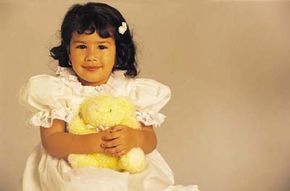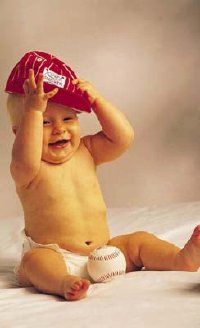Generally speaking, a good toy should challenge a child at his level of development. If it's too sophisticated, it frustrates the child; if it's too simple, it bores the child. So it's important to observe the age ranges on packages.
A good toy requires the child to actively play with it; if the toy does the playing, it won't interest the child for very long.
Infants: Birth to 1 Year
The major safety concern during this period is choking and suffocation.
Make sure stuffed toys are nonflammable, non-toxic, and washable. Stuffed animals that are all one piece are best; any limbs should be securely attached. Features should be painted or embroidered, and the toy should not have embellishments, such as glass eyes or whiskers, children can pull off and swallow. Small, lightweight toys are easier for infants to hold and cuddle.
Mobiles help develop a baby's ability to focus attention on objects, but they are meant to be looked at only -- not handled. Once your child is old enough to reach up and grab the mobile (usually at about four to five months), remove it.
Rattles and teething rings must be unbreakable and washable, have no loose parts, and have rounded stems. No part of a rattle should be small enough to fit in a baby's mouth. To test this, draw an oval that is 1 3/8 inches x 2 inches on a piece of paper and cut it out. If the rattle or any part of it can pass through the hole to a depth of 1 3/16 inches or more, the rattle could choke your child. You can purchase rattles in a variety of shapes, sizes, and colors. Be sure the size and weight are compatible with your child's ability to grasp it in one hand.
Crib and playpen exercisers usually stretch across the crib or playpen and enhance pulling and grasping. Remove them before babies are big enough to use them to pull themselves up.
Special balls that make noise and have moving pieces inside provide motor, visual, and aural stimulation and help develop eye movement, crawling, and gross motor skills. Be sure your child cannot remove the moving pieces from the ball.
Mirrors delight infants. But make sure they are unbreakable, have no sharp edges, are light enough for your baby to pick up, and are large enough not to be swallowed.
Toddlers: 12 to 18 Months
At this point, babies can stand and sit but may not yet walk by themselves. They enjoy moving objects, such as push-pull toys that make sounds, toys that open and close and involve turning knobs and dials, and peek-a-boo games.
At this age, children enjoy blocks, but be sure to get large blocks that have no sharp corners. Just a few blocks will suffice; too many confuse a baby. Blocks covered with soft fabric and light, foam-filled vinyl blocks are ideal.
Sorting toys teach children about color and size and enhance manual dexterity, but make sure they are unbreakable and pieces are too large for your child to swallow.
Riding toys are dangerous for children who can't yet walk. But children who can walk enjoy them.
Make sure your child can climb on and off the toy easily and maneuver it alone. Also make sure it has no sharp edges.
Push-pull toys are great for kids who are already walking, too. Make sure the ends of the handles are covered with large safety balls and all the parts are unbreakable.
Toddlers: 18 to 24 Months
Children at this age are talking and are interested in learning about size and placement.
Large blocks in a variety of shapes interest children at this age. Start out with a small set and move on to a large set as the child's interest develops. Avoid blocks with sharp edges. Blocks that come in canisters are easiest for a child to put away when play is through. Blocks are a good investment; they hold children's interest for a long time. They are usually appropriate from the age of 18 months to 8 years.
Telephone toys give children an opportunity to engage in an adult activity, and children like the noise they make. Some of these toys even talk. Those shaped like cartoon characters help maintain interest. Be sure bell parts cannot be removed and swallowed.
Shape-recognition toys that require children to fit pieces in appropriately shaped holes help develop hand-eye coordination, matching skills, and shape recognition. However, if the toy has too many pieces, the child will be frustrated. Watch for pieces of swallowable size and holes that can pinch or trap fingers.
Action toys, such as a push-pull bus with removable people, are very popular with children at this age, as are push-pull train sets with removable accessories. Make sure all parts are swallow-proof.
Pounding toys teach hand-eye coordination and enhance gross and fine motor skills. Any hammer should be very soft, so the child isn't injured by it.
Riding toys come in two types: those the child moves by pushing with her feet and those with pedals. The latter are more difficult for children to use. All riding toys should be stable and easy to mount. They are usually appropriate for children 18 to 36 months of age. Always supervise a child using a riding toy outdoors, particularly near sidewalks or streets.
Activity toys are those that children either crawl or climb on or use to develop manual dexterity. Climbing toys should have railings and other safety features. Toys that enhance dexterity should be suited to your child's abilities; they should be challenging but not frustrating.
Toddlers: 2 to 3 Years
At this point, children are more creative. They employ make-believe and fantasy in their play. Their attention spans are longer. They enjoy adult-like activities, and realistic toys stimulate hours of creative play. This age group enjoys toys that require movement as well as those that involve dexterity.
Talking toys and dolls are very appealing. Make sure the dolls speak their phrases clearly, and the pull ring is securely attached.
Toy dashboards are popular, too. The more features the dashboard has, the more interest the child has in it. Just make sure it's easy to use. Avoid toys with knobs or decals the child can easily pull off.
Trucks are good toys for indoors and outdoors, especially for the sandbox. Trucks that have moving parts are especially appealing, but be sure there are no sharp edges and the metal is rust-proof. Choose trucks that are stable and maneuverable with wheels securely attached.
Push or wind-up trains are popular. Your child should be able to easily place the train on its tracks, though an adult usually needs to assemble the tracks. Make sure wind-up mechanisms are easy to use, and avoid toys with sharp edges.
Check for durability of toy kitchens and realistic tool toys. Make sure these toys are manageable for your child, or they won't sustain interest. Also be sure that large items are stable and won't fall on your child during play. Tool benches should provide a variety of activities without being overwhelming.
Puzzles can be an excellent purchase. They strengthen hand-eye coordination, matching skills, and shape recognition, and sustain interest if matched to your child's skill level. Puzzles suitable for all ages are available. Pieces should not be so small as to encourage your child to pop them in his mouth.
Play scenes provide a child with the opportunity to use her imagination. These toys often have more appeal if the scenes are familiar, so a city child may enjoy a toy parking garage more than a farm scene. (Then again, the farm scene might be an excellent way to introduce your city child to life on a farm.) The toys should be easy to assemble, have storage for individual pieces, and have moving features. Also, be sure your child isn't overwhelmed by a multitude of pieces.
Occupation toys, such as a doctor's kit, inspire creative play. A child familiar with the occupation it represents will appreciate the toy.
When choosing a toy for a child your first concern should be that the toy is safe. But, apart from just not causing harm, toys can also help your child grow and develop. A child's play is vitally important to their creativity and imagination.
For more useful tips and information, visit the links on the next page.
©Publications International, Ltd.
About the Contributor:
Alvin Eden, M.D.: Alvin Eden, M.D. serves as a Clinical Professor of Pediatrics at the Weil Medical College of Cornell University in New York, New York. He is Chairman of the Department of Pediatrics at the Wyckoff Heights Medical Center in Brooklyn. Dr. Eden is also the author of a number of child care book, including Positive Parenting and Growing Up Thin.
This information is solely for informational purposes. IT IS NOT INTENDED TO PROVIDE MEDICAL ADVICE. Neither the Editors of Consumer Guide (R), Publications International, Ltd., the author nor publisher take responsibility for any possible consequences from any treatment, procedure, exercise, dietary modification, action or application of medication which results from reading or following the information contained in this information. The publication of this information does not constitute the practice of medicine, and this information does not replace the advice of your physician or other health care provider. Before undertaking any course of treatment, the reader must seek the advice of their physician or other health care provider.



